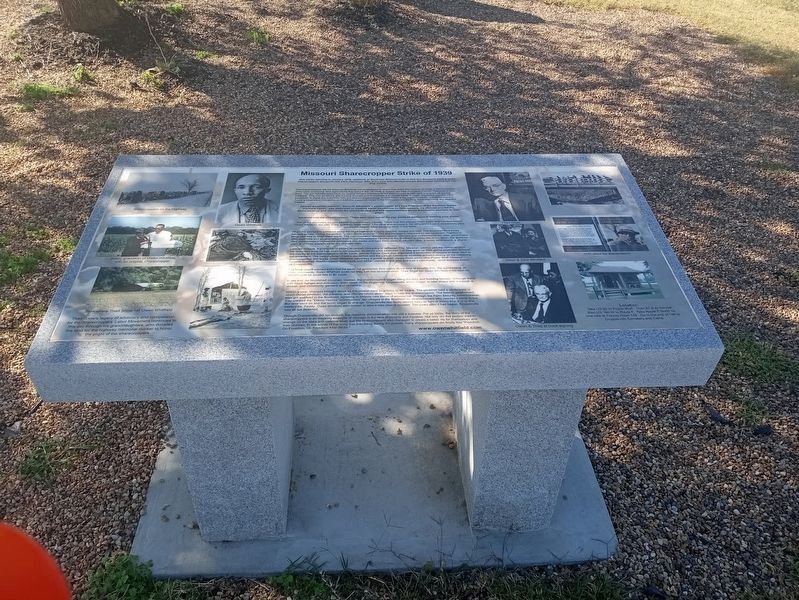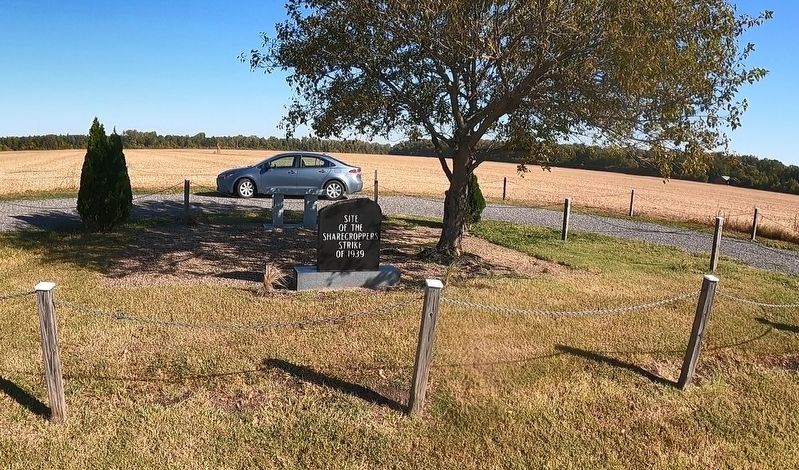Tywappity Township near Charleston in Mississippi County, Missouri — The American Midwest (Upper Plains)
Missouri Sharecropper Strike of 1939
The sharecroppers left the Missouri Bootheel cotton plantations where they lived and worked, to stage a demonstration. They were protesting "The Agricultural Adjustment Act," of 1938, a federal law from President Franklin Roosevelt's New Deal. The act reduced production by paying farmers subsidies to not plant on part of their land and to kill off excess livestock. This was to reduce any surplus in crops and to increase the market value of crops. Plantation owners were supposed to share the subsidies with the sharecroppers living on and working the fields, however, plantation owners found a loophole in this policy and kept the subsidies owed to the sharecroppers by fining them and hiring day laborers instead.
African American minister, 'Owen H. Whitfield, a sharecropper and Vice-President of the Southern Tenant Farmers Union,' was dedicated to creating better conditions for farm workers. He planned and led the demonstration and convinced the sharecroppers that this demonstration would draw public attention to their plight.
Whitfield told the sharecroppers: "Take your eyes out of the sky, because someone is stealing your bread."
Not all the plantation owners treated sharecroppers unjustly. There was one planter, Thad Snow who had befriended Owen Whitfield, his wife, Zella, and their large family. Like other sharecroppers, the Whitfield's lived in desperately poor conditions despite back-breaking labor in the fields.
When the protesters gathered along the frigid highways in early January, hungry and cold, the American Red Cross refused to help, calling the protest "a man-made disaster." The sharecroppers remained on the roadsides, huddled in tents with little to keep them warm. The demonstration attracted national attention and embarrassed the state government after reporters and photographers from major newspapers traveled to the Bootheel to follow the crisis. Soon, the governor sent state troopers to load the protesters into trucks and haul them away to different sites: a levee, swampland, a church yard, and other places - all far out of public view.
Lorenzo Greene, a professor of history at Lincoln University in Jefferson City, Missouri, went to visit the demonstrators. He described what he had seen to his classes. Students were so moved that they gave up their spring prom and donated the money to the sharecroppers. In St. Louis, activist Frannie Cook also organized a committee of citizens to send relief
to the protesters. The next summer, Cook's committee and the Lincoln University students donated money so the remaining sharecroppers, still led by Owen Whitfield, could buy a parcel of land: ninety-three acres near Poplar Bluff, Missouri. Several hundred sharecroppers - both black and white - moved to the land and built a community, which became known as Cropperville.
The local sheriff warned them that he could not guarantee their safety in the face of hostility from the surrounding, all-white community. Owen Whitfield could not stay with the demonstrators; Thad Snow hid Owen Whitfield in his barn for months until he could flee to St. Louis.
In the end, no bloodshed occurred. Instead, the sharecroppers began tilling the land and building houses. Although there was much hunger and sickness -- even death in the beginning, Cropperville slowly began to take shape with a school, a church, and community gardens and cemetery.
Within a year, changes brought about by the protest were beginning to be visible. The governor held a conference in which Owen Whitfield, the planters, and officials talked about ways to help the sharecroppers. The federal government also got involved in the Bootheel, agreeing to provide new forms of assistance. Through the Farm Security Administration, they created the "Delmo Homes" communities: ten villages in the Bootheel for sharecroppers who needed a place to live. But time went on and the world began to change. Cropperville residents moved away to fight in World War II or to find better jobs. Finally, Owen Whitfield also moved to take a new church position. Ten years after it had begun, Cropperville was all but deserted.
Though Cropperville did not endure, the roadside demonstration was still a success. For us today, the story of the sharecroppers is an inspiring example of courage in the face of poverty and injustice. Not only did this protest lead to change on the state and national level, but the sharecroppers also managed to create a better life for themselves and their children. In the words of the song that they sang during the protest, many sharecroppers did finally find "Freedom, Oh Freedom, Oh Freedom After While."
(photo caption:)
Thad Snow's legacy of advocacy and compassion for the Sharecroppers' Labor Movement continues to this day through his granddaughters, who donated the land for the highway memorial marker to honor the plight of the sharecroppers.
Topics. This historical marker is listed in these topic lists: African Americans • Agriculture • Industry & Commerce • Labor Unions. A significant historical month for this entry is January 1939.
Location. 36° 55.322′ N, 89° 16.248′ W. Marker is near Charleston, Missouri, in Mississippi County. It is in Tywappity Township. Marker is on U.S. 62, on the right when traveling west. Marker is on a roadside pullout. Touch for map. Marker is at or near this postal address: MO-77, Charleston MO 63834, United States of America. Touch for directions.
Other nearby markers. At least 8 other markers are within 8 miles of this marker, measured as the crow flies. Mississippi County (approx. 1.8 miles away); Mississippi County War Memorial (approx. 4.4 miles away); Warren Eastman Hearnes (approx. 4.4 miles away); The Lewis and Clark Expedition Across Missouri (approx. 4.6 miles away); Riverlore (approx. 7.7 miles away in Illinois); Magnolia Manor (approx. 7.8 miles away in Illinois); The Cairo Public Library (approx. 7.8 miles away in Illinois); African American Troops in the Civil War (approx. 7.8 miles away in Illinois). Touch for a list and map of all markers in Charleston.
More about this marker. This marker replaced an earlier marker.
Regarding Missouri Sharecropper Strike of 1939. The website address for owenwhitfield.com does not work as of February 2023.
Also see . . .
1. Thad Snow papers (PDF). PDF link to The State Historical Society of Missouri on Thad Snow. Very little information can be found about him other than book reviews. This PDF gives a good account of his life. (Submitted on February 19, 2023, by Jason Voigt of Glen Carbon, Illinois.)
2. The Whitfield Foundation. The Whitfield Foundation entry (Submitted on February 19, 2023, by Jason Voigt of Glen Carbon, Illinois.)
Credits. This page was last revised on February 19, 2023. It was originally submitted on February 19, 2023, by Jason Voigt of Glen Carbon, Illinois. This page has been viewed 416 times since then and 89 times this year. Photos: 1, 2. submitted on February 19, 2023, by Jason Voigt of Glen Carbon, Illinois.

